
Essi Ryymin, Anne-Maria Korhonen, Katja Maetoloa & Hanna Lindroos
Digitalisation is transforming work and learning, and digital competences are nowadays needed in every vocation. For small and medium-sized companies (SMEs) digital transformation opens promising opportunities to expand and create news businesses. However, developing new skills may sometimes be challenging in every day working settings. Digital competence development is a lifelong endeavour that requires systematic approach to learning at work. Embedded learning and working environments encourage personalised, team-based and organisation level learning, and offer resources for continuous competence development at work.
The Future Work research team (n.d.) of HAMK Edu contributed to the European development project DC4WORK (Work-based learning in a digital age – promoting digital competences for better employability & innovation) in 2017–2019. The goal of the Erasmus+ -funded initiative was to research and promote digital competences, in reference to the EU’s Digital Competence Framework 2.0 (EU Science Hub, n.d.) and continuous learning in small and medium-sized enterprises. There were five countries collaborating on the project: Austria, Belgium, Finland, Germany and Portugal. The partners compared their national policies and flagship development projects of digitalisation and applied research of digital competences in SMEs.
On the basis of the study results, the project partners developed an open web-based “Toolbox 4.0” for the use of digital promoters in companies and in educational institutions (www.dc4work.eu) as well as guidelines to support promoters in facilitation of learning digital competences at work. The contribution of Finnish partners focused on pedagogical expertise, for instance, developing learning methods and models for continuous learning at work and facilitating collaboration between educational institutions and companies. The methods included e.g. the development of an open digital badge and a MOOC (massive open online course) for facilitating digital competences (DC4WORK project, 2019a). This article focuses on the case study of SMEs in Finland. It introduces the study results of a survey and interviews generated in Finland. Based on the study results, intense dialogue with companies and training experimentations, draws a working model for learning digital competences at work.
Digitalisation transforming businesses and learning
Digital competence development in SMEs has been under great concerns recently. According to Hubschmid-Vierheilig, Rohrer and Mitsakis (2019, p. 9) there is an urgent need to further study and discuss the importance of digital competences within SMEs, because for most European economies, SMEs are the drivers of economic prosperity due to their specific expertise and innovation potential growth. (See also Lindner & Leyh, 2017) However, SMEs often find themselves in conflict to meet long term strategic goals and to live up to the challenge of a fast-paced digitalisation of their business environment; there is a necessity to employ and develop digitally competent workforce.
Lehner and Sundby (2018, p. 55) also emphasise that SMEs are very powerful and of great importance for the economy. The number of SMEs counts to 21.2 million in Europe or almost 67% of total employment and as many as 99.8% of all enterprises in the non-financial business sector. The knowledge, skills and abilities to handle digital systems have become an indispensable asset and success factor. Despite of the importance of digitalisation in SMEs, the exploitation is not sufficient, as a result of skills and competence deficits within the workforce. This applies to companies of all sizes, although SMEs are known to be slower than large ones to adopt new information technologies.
DC4WORK project focuses on the sectors of tourism and commerce. SMEs play quite a significant role in the employment and economy in Finland. Of all private-sector employees, as many as 65% work for companies employing fewer than 250 people. These enterprises generate about 58% of the combined turnover of all Finnish businesses. SMEs are responsible for more than 16% of Finland’s export revenue (Suomen Yrittäjät, 2019).
Finland’s tourism industry has grown and become more international at a faster pace than other sectors in recent years. Development of tourism in Finland is guided by “Achieving more together”, the roadmap for growth and renewal in Finnish tourism for 2015–2025. The aim is to make Finland the number-one tourist destination in Northern Europe by 2025. Tourism has become an important export sector and provider of employment. For many years, the revenue generated by tourism has been more than 14 billion euros and it may even reach 20 billion euros by 2025 (Ministry of Economic Affairs and Employment, 2017).
Survey of digital competences in SMEs
DC4WORK project consortium designed the survey of digital competences of SMEs in the guidance of Mentortec, Portugal (Monteirto, 2018). The survey was based on EU’s Digital Competence Framework 2.0 (EU Science Hub, n.d.) highlighting the competence areas of information and data literacy, communication and collaboration, digital content creation, safety and problem solving.
The survey was addressed to SMEs’ owners, employers and educational experts of the fields of trade and tourism. The results of all 100 respondents from five participating countries were reported in the final report of DC4WORK project (Monteirto, 2018). This article introduces the results of the survey in Finland. There were altogether 26 respondents to the online survey from Finland, 13 women and 13 men. Fourteen of the respondents represented SMEs, six (6) represented VET institutions of trade and tourism (higher education or vocational education) and six (6) persons represented freelancers and solo entrepreneurs in tourism and trade.
According to the respondents, digital competence requirements were strongly increasing especially in custom services, development and marketing (Figure 1). The respondents also had strong policies related to the assessment and promotion of digital competence of their employees. In the statement “We have skilled employees with the necessary digital competences to use and benefit from the digital devices in our company” thirty respondents (8%) chose “fully applies” (Figure 2). The respondents also assessed that employees were open to the digital revolution at the workplace (34.6% fully applies) and expressed to have a clear strategy focused on the promotion and assessment of digital competences in the company (38.5% fully applies). This positive approach may be explained by the responder groups interest in the benefits of digitalisation. By the look of it, the respondents of the survey were generally interested and positive on the topic of discussion and may be active in digitalisation in SMEs and or in education of digital competences.
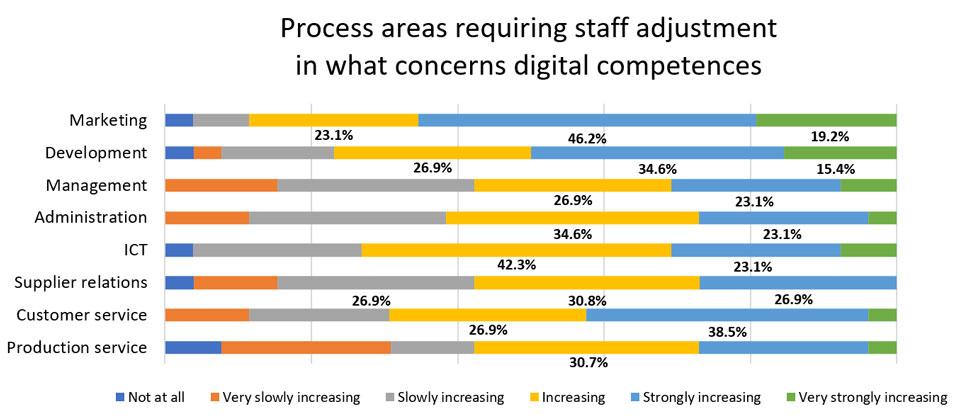
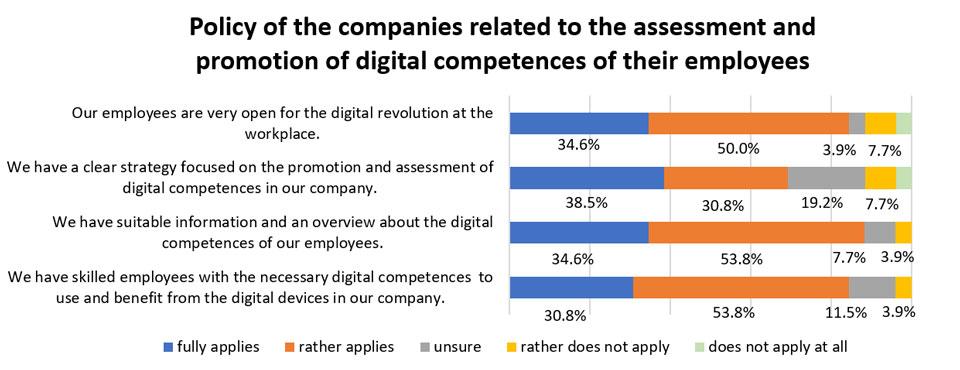
The respondents also evaluated how relevant the contents of the digital competences introduced in EU’s Digital Competence Framework 2.0 are in their own work. For example, the contents of information and data literacy (Figure 3) including, e.g. “browsing, searching, filtering data, information and digital content” were mainly considered crucial or relevant.
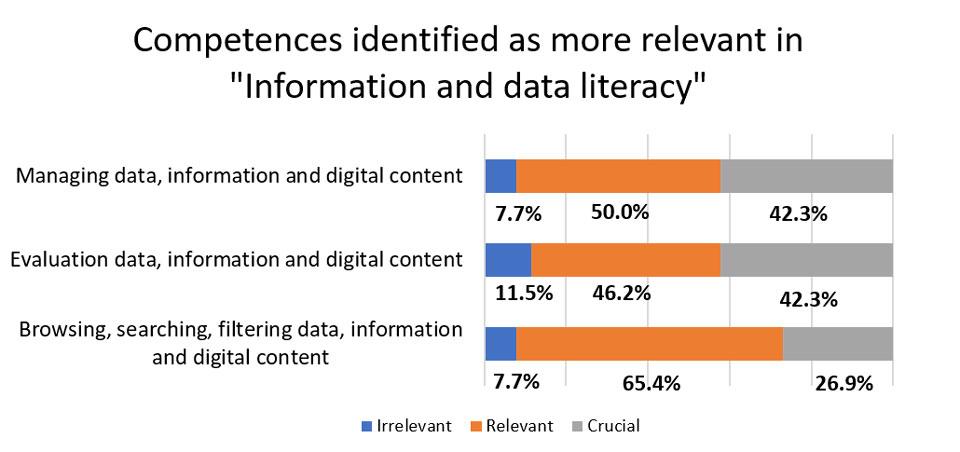
When focusing on problem solving, the contents were still crucial or relevant, emphasising slightly “creatively using digital technologies” (Figure 4).
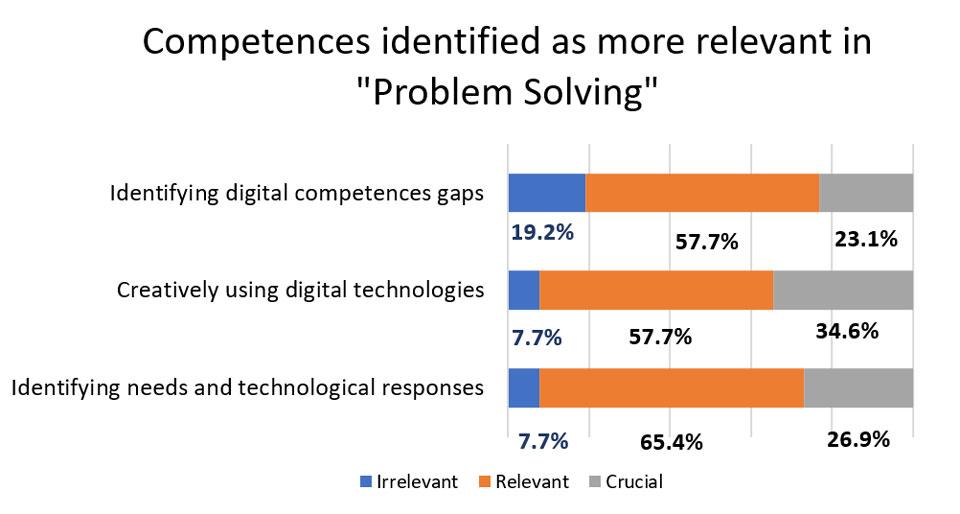
The respondents also found competences related to “Communication and collaboration” important, highlighting interaction and netiquette (Figure 5).
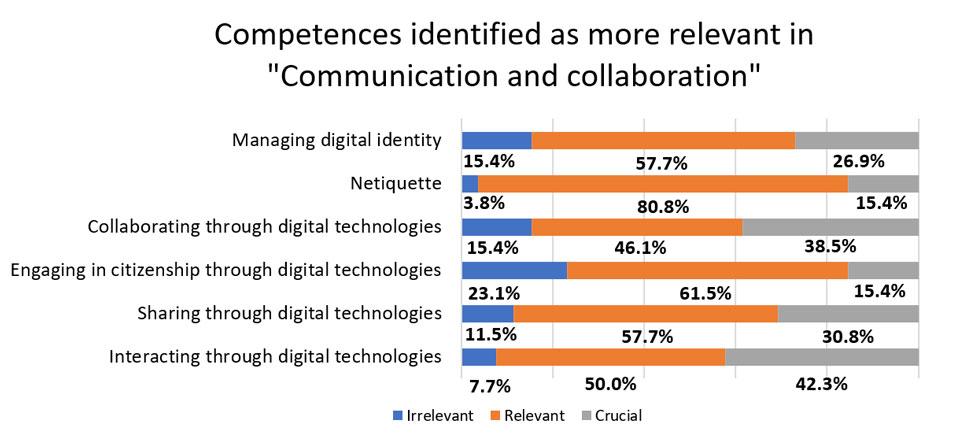
In digital content creation, elaborating and re-elaborating digital content were considered important competences, however, programming was not considered crucial among this group of respondents (Figure 6).
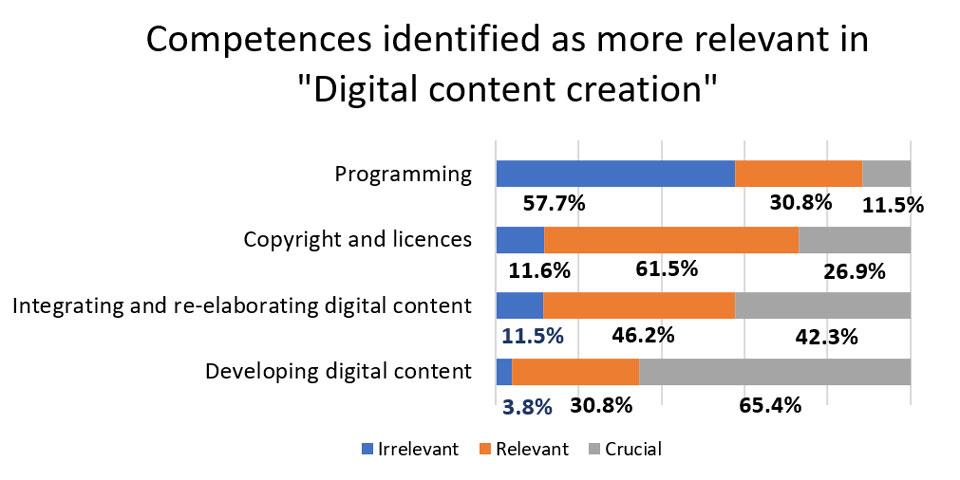
When considering safety, the respondents highlighted protecting devices over protecting health and well-being, though all contents were still reflected to be important (Figure 7).
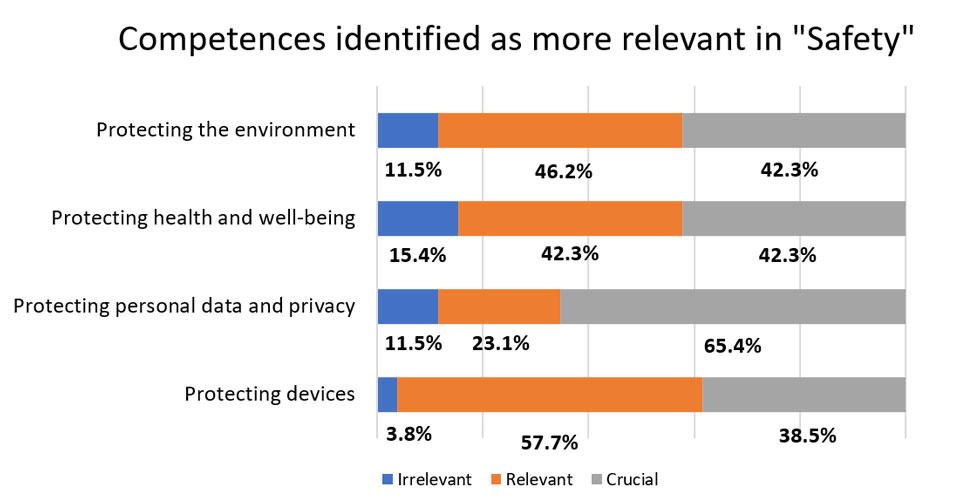
In this survey, the respondents were surprisingly like-minded of the relevance of the digital competences, despite of their backgrounds, showing interests and positive attitude towards digital competence development in general. In further studies, it would be interesting to find opposite opinions and critical approaches to digital development of SMEs for comparison and for understanding the development deeper. For example, what supports or challenges learning digital skills at companies? What are the benefits or challenges of digitalisation in everyday work from the point of view of employees?
Needs and trends identified in expert interviews
Altogether ten (10) experts participated in expert interviews that were carried out either in face-to-face interviews or, in some cases, via the internet. There were seven (7) women and three (3) men participating in the interviews. Three (3) of the participants represented universities or vocational institutions in the field of business with specific interest of developing collaboration between educational institutions and SMEs. Four (4) of the interviewees were SME-entrepreneurs, one of them working in clothing business and three in tourism. Also, three freelance guides and developers of tourism sector were interviewed. Altogether, there were four experts of trade and six experts of tourism involved in the process. Interviews were written down as a raw text during the interviews. The qualitative analysis was done in a team of researchers discussing the research process and results ensuring that no important ideas were lost. Specific attention was paid to “repeating ideas” (Auerbach & Silverstein, 2003, pp. 45–46) which were organised into the following categories.
Forward-going tourism
In general, digital competences were considered crucial in an actual economic setting. Altogether seven (7) interviewees considered content creation as the most or second important digital competence at work. Six (6) interviewees considered communication and collaboration as the most or second important of the competences. In content creation, the experts highlighted social media, digital storytelling in marketing, websites, digitally attractive and usable web shops and services and visualisations enhancing positive customer experience. Communication and collaboration competences were linked several times to content creation in discussions. For instance, the interviewees stressed the importance of digital brand building and meaningful content creation as a part of it. The interviewees pointed out that there are active companies especially in tourism that blog and vlog of “adventurous travelling” and create appealing content by a variety of applications and media, e.g. augmented and virtual reality (AR/VR).
“I can’t run my tourism business without digital skills. Everything is integrated, from websites to social media.” (An interviewee)
Challenges in trade sector
Considering the trade sector, the interviewees expressed that customers seem to be merely interested in web shops rather than traditional shops (especially in clothing). The interviewees assumed that digital applications are not in as active use in the trade sector as they could be. Employees need more examples, training, hands-on tutoring and learning by doing in order to use digital tools in re-creation of business and services. At the same time, the software offered to shopkeepers keeps evolving and Web 4.0 offers many possibilities to refresh the image and brand of the traditional retail shop and market products more efficiently.
Digital tools
Number of digital tools were mentioned during the interviews that have already proven useful in innovative tourism and trade, for example digital guide and information services for travellers, digital storytelling, customer feedback and social endorsement applications, online bookings, apps for following customer flow and free tools for marketing and automated storage and document handling. The interviewees expected that in the near future mobile devices and sensors can automatically recognise customers’ needs and enhance customer experience. One can, for example, browse content via virtual glasses and simulate services before purchasing a product or service.
Need for new solutions for competence development
According to the interviewees, SMEs do not very often have a specific strategy or an action plan for digitalisation and learning process of digital competences is not guided nor systematic. There may be many reasons for that, for instance, the lack of resources, tools, motivation and training possibilities. It is not easy for an entrepreneur to “leave the job” to join in-service training. More flexible solutions for learning at work during everyday activities are needed.
The interviewees reflected on learning possibilities for SMEs. They stated that individual and informal learning is possible at any time by online materials and courses. Peer learning and tutoring as well as learning from a colleague (e.g. from social media or from videos) or in a network can also be efficient on-the-job learning methods. Of course, if one learns by doing, experimenting and reflecting, it is crucial to find new digital solutions. Formal training should always be linked to practical, real-life doing and in company work assignments. Sometimes learning is best achieved by personal guidance and here collaboration between an educational institution and a company can offer new choices. Digital native students can visit companies and tutor digital skills and ideas to entrepreneurs, meanwhile they gain valuable work experience. SMEs can also organise the necessary training together with educational institutions and their own networks and unions regionally.
“We need someone to visit us, to tutor, guide and show in practice at working place, how to use my digital applications and what kind of new possibilities there are.” (An interviewee)
A working model for digital competence development
The previous chapter concluded the results of the survey and the interviews in the frame of reference of digital competence development. During the DC4WORK process, the Future Work research team contributed to planning and experimenting digital training solutions and observed and had a dialogue with several SMEs for understanding better the context of work for continuous learning (DC4WORK project, 2019b). The team also video recorded some of the cases, for instance, the interview of an entrepreneur of her social media use in marketing (DC4WORK project, 2019c). Currently, in addition to SMEs, The Future Work research team also collaborates with large companies in continuous learning and competence development and is actively looking for new research partnerships with companies and other educational practitioners with the interest in continuous learning.
On the basis of their project observations, and also from their earlier experience and expertise in research and development of digital competences (see e.g. in Korhonen, Lakkala, & Veermans, 2019; Korhonen, Ruhalahti, & Veermans, 2019; Ryymin, Korhonen, & Niinimäki, 2019; Ryymin, Palonen, & Hakkarainen, 2008; Ryymin, Veermans, & Lakkala, 2005) the team has designed “the working model” of digital competence development (Figure 8) in companies. The purpose of the conceptual model is to sum up project conclusions and findings and support the future development, training and research planning. The model includes practical and applicable solutions and approaches for digital competence development and continuous learning at work. The next chapter sums up the basic elements of the model briefly. The more detailed description, further studies and discussions of the topics are under process.
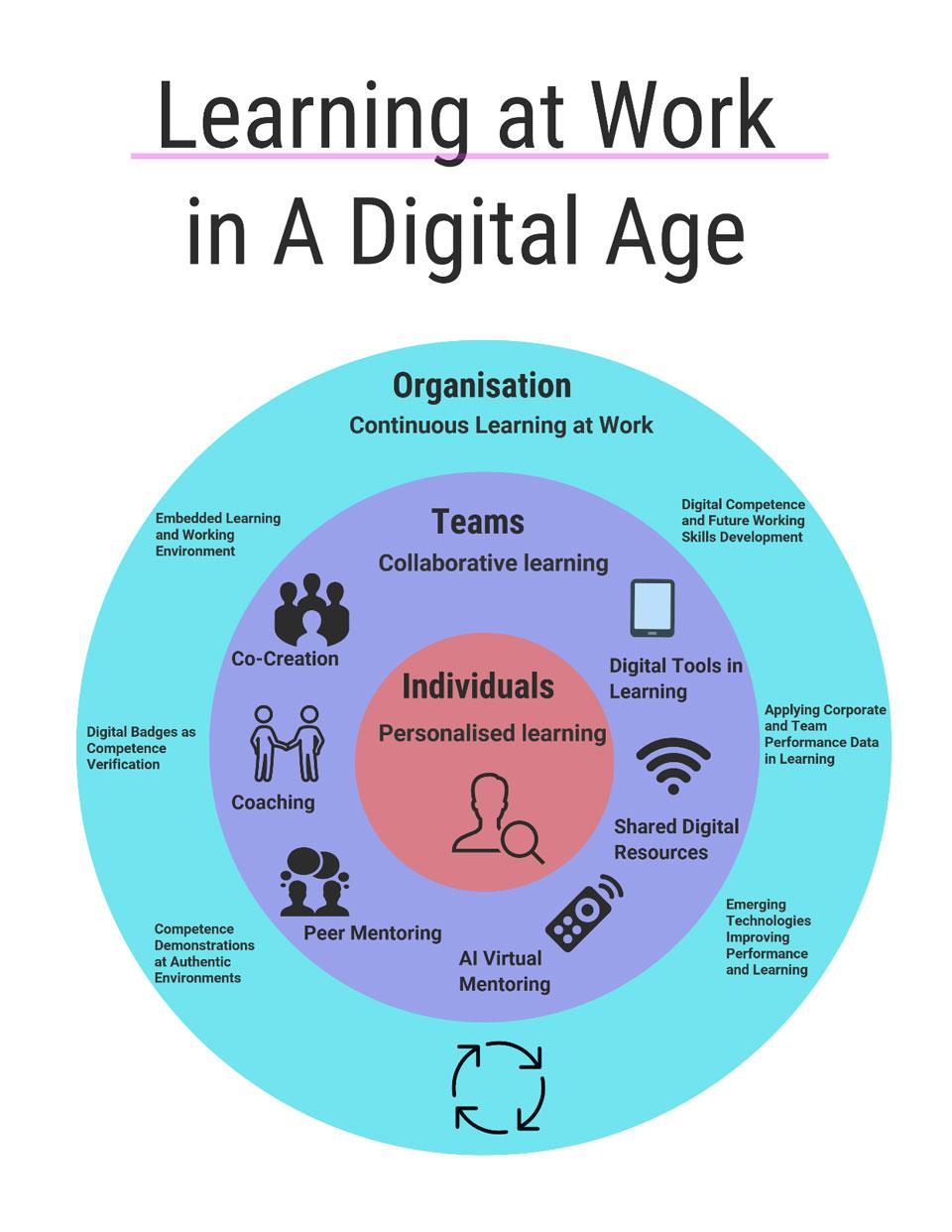
The model includes three aspects on competence development: individual, team and organisational learning. The model aims to link continuous learning at all three levels following Sessa and London’s (2015) idea that individuals, groups, and organisations are living systems with internal learning mechanisms that can be activated and supported or stymied and thwarted. Once activated, systems can learn adaptively by reacting to a change in the environment; they can learn by generating new knowledge and conditions; and/or they can transform by creating and applying frame-breaking ideas and bringing about radically new conditions.
Personalised learning aims to customise competence development for an employer’s current needs, skills, and interests, and varies the time, place, and pace of learning for each learner, enlists the learner in the creation of learning pathways, and utilises digital tools to manage and document the learning process and access rich sources of information. (Murphy, Redding, & Twyman, 2016; Chen, Huang, Shih, & Chang, 2016). There is a range of digital services and tools that can support personalised learning at work, and especially with the growth of artificial intelligence, there are remarkable new possibilities to design and implement personalised learning and mentoring (Baylor, 2000; Toala, Gonçalves, Durães, & Novais, 2018).
Learning in teams (e.g. Altman & Iles, 1998) is an important resource for competence development in corporate learning; co-creation means that employees are creating something in collaboration with each other and, more importantly, with customers and trading partners for instance when developing digital marketing, business models, new products and services. Co-creation as a professional discipline is a set of capabilities, models, skills, methods and activities that enable the act of co-creation (Prahalad & Ramaswamy, 2004).
Employees can also coach each other. For instance, experts can coach novices or digital natives coach digital immigrants (Autry & Berge, 2011). Peer mentoring (Colvin & Ashman, 2010) may enhance supportive relationships between employees sharing knowledge and experience and provide an opportunity to learn from each other. Digital tools and shared digital resources offer many possibilities at work to enhance knowledge sharing and learning in teams.
In embedded learning and working environment open digital badges (Muilenburg & Berge, 2016) offer a new way to recognise and communicate competencies. Open badge is a digital recognition of someone’s achievement or status. It is typically issued by a learning provider or an employer for completing a certain task and a goal. The issuer creates the criteria that one needs to fulfil in order to achieve the badge. The criteria are embedded in the badge itself in the form of metadata, along with the information about the issuer, the date when the badge was issued and link(s) to the evidence of the acquired skills/knowledge/competence and the like (Jovanovic & Devedzic, 2014, p. 56).
Digital badging can verify and integrate credentials produced in formal and informal settings to provide a comprehensive demonstration of what people know and can do in an authentic working environment. (Muilenburg & Berge, 2016.) Developing digital competences in companies is a continuous process and requires proactivity and follow-up of emerging technologies (Huda et al., 2018) that may offer new, transformative methods for learning at work.
Acknowledgements
We would particularly like to thank Andrea Monteitro from Mentortec for her support in survey data graphics and Nana Niskanen and Marja Laurikainen from HAMK for their valuable contribution to qualitative data gathering.
Authors
Essi Ryymin, Principal Research Scientist; Anne-Maria Korhonen, Senior Lecturer; Katja Maetoloa, Educational Developer, and Hanna Lindroos, Project Coordinator at HAMK Edu Research Unit, Häme University of Applied Sciences.
References
Altman, Y. & Iles, P. (1998). Learning, leadership, teams: corporate learning and organisational change. Journal of Management Development, 17(1), 44–55. https://doi.org/10.1108/02621719810368682
Auerbach, C., & Silverstein, L. B. (2003). Qualitative Data: An Introduction to Coding and Analysis. New York University Press: ProQuest Ebook Central.
Autry, A. & Berge, Z. (2011). Digital natives and digital immigrants: getting to know each other. Industrial and Commercial Training, 43(7), 460–466. https://doi.org/10.1108/00197851111171890
Baylor, A. (2000). Beyond Butlers: Intelligent Agents as Mentors. Journal of Educational Computing Research, 22(4), 373–382. https://doi.org/10.2190/1EBD-G126-TFCY-A3K6
Chen, S.Y., Huang, P.-R., Shih, Y-C. & Chang, L.-P. (2016). Investigation of multiple human factors in personalized learning. Interactive Learning Environments, 24(1), 119–141. https://doi.org/10.1080/10494820.2013.825809
Colvin, J. W. & Ashman, M. (2010). Roles, Risks, and Benefits of Peer Mentoring Relationships in Higher Education. Mentoring & Tutoring: Partnership in Learning, 18(2), 121–134. https://doi.org/10.1080/13611261003678879
DC4WORK project. (2019a). Digital Competence Facilitator MOOC. Retrieved 23 November 2019 from https://sites.google.com/view/digital-competence-facilitator/home
DC4WORK project. (2019b). Methods how to improve digital competences in your company. Retrieved 23 November 2019 from https://www.dc4work.eu/unit-3-improve
DC4WORK project. (2019c). Digital Marketing. Interview of Kata Rewell, Entrepreneur and owner of DOPP. Video recording [in Finnish, subtitling in English]. Retrieved 23 November 2019 from https://www.youtube.com/watch?v=HzaisKWfNWY
EU Science Hub (n.d.) The Digital Competence Framework 2.0. Retrieved 23 November 2019 from https://ec.europa.eu/jrc/en/digcomp/digital-competence-framework
HAMK. (n.d.). Future Work Research and Development. Retrieved 23 November 2019 from https://www.hamk.fi/research/hamk-edu/future-work-research-and-development/?lang=en
Hubschmid-Vierheilig, E., Rohrer, M., & Mitsakis, F. V. (2019, June 24–26). Digital competence and SMEs: review of the relevant literature. Paper presented at The 20th International Conference on Human Resource Development Research and Practice across Europe (UFHRD), Nottingham. Retrieved 7 November 2019 from 2018 http://irep.ntu.ac.uk/id/eprint/37009
Huda, M., Maseleno, A., Atmotiyoso, P., Siregar, M., Ahmad, R., Jasmi, K. & Muhamad, N. (2018). Big Data Emerging Technology: Insights into Innovative Environment for Online Learning Resources. International Journal of Emerging Technologies in Learning (iJET), 13(1), 23–36. Retrieved 23 November 2019 from https://www.learntechlib.org/p/182240
Jovanovic J., & Devedzic, V. (2014). Open Badges: Challenges and Opportunities. In E. Popescu, R.W.H. Lau, K. Pata, H. Leung, & M. Laanpere (Eds.), Advances in Web-Based Learning – ICWL 2014. Lecture Notes in Computer Science, 8613. Cham: Springer.
Korhonen, A.-M., Lakkala, M. & Veermans, M. (2019). Identifying vocational student teachers’ competence using an ePortfolio. European Journal of Workplace Innovation, 5(1).
Retrieved 23 November 2019 https://journal.uia.no/index.php/EJWI/article/view/512
Korhonen, A. M., Ruhalahti, S., & Veermans, M. (2019). The online learning process and scaffolding in student teachers’ personal learning environments. Education and Information Technologies, 24(1), 755–779.
Lehner, F., & Sundby, M. W. (2018). ICT Skills and Competencies for SMEs: Results from a Structured Literature Analysis on the Individual Level. In C. Harteis (Ed.), The Impact of Digitalization in the Workplace. Professional and Practice-based Learning, 21. Cham: Springer.
Lindner, D., & Leyh, C. (2017). Der digitale Arbeitsplatz – KMU zwischen Tradition und Wandel [In German] [The digital workplace – small and medium enterprises between tradition and change]. HMD Praxis der Wirtschaftsinformatik, 2017, 54(6), 900–916. https://doi.org/10.1365/s40702-017-0370-x
Ministry of Economic Affairs and Employment, Finland. (2017). Achieving more together – the Roadmap for Growth and Renewal in Finnish Tourism for 2015–2025. Retrieved 11 November 2019 from https://tem.fi/documents/1410877/2735818/Summary+Roadmap+for+Growth+and+Renewal+in+Finnish+Tourism+for+2015%E2%80%932025.pdf/aaf8ecb3-1af2-4891-a62c-8b5078fed39b
Monteirto, A. (2018). Work-based learning in a digital age – study on training needs and trends of the tourism and trade sector. DC4WORK project No. 2017-1-DE02-KA2002-004185 research documents. Retrieved 23 November 2019 from https://www.dc4work.eu/fileadmin/user_upload/dc4work/0_uebergreifend/Work-Based_Learning_in_a_digital_age-Final_Report.pdf
Muilenburg, L. Y., & Berge, Z. L. (2016). Digital Badges in Education – Trends, Issues and Cases. New York and London: Routledge.
Murphy, M., Redding, S., & Twyman, J. (Eds.) (2016). Handbook on Personalized Learning for States, Districts, and Schools. Philadelphia, PA: Temple University, Center on Innovations in Learning. Retrieved 3 April 2020 from https://files.eric.ed.gov/fulltext/ED568173.pdf
Prahalad, C., & Ramaswamy, V. (2004). Co-Creation Experiences: The Next Practice in Value Creation. Journal of Interactive Marketing, 18, 3.
Ryymin, E., Veermans, M., & Lakkala, M. (2005). Dissemination practices of technology-supported inquiry learning. Ammattikasvatuksen aikakauskirja, Special Edition, 65–84.
Ryymin, E., Korhonen, A.-M. & Niinimäki, J. (2019). Opettajien digipedagogiikan koulutus ennakoi työelämän murrosta [The digipedagogy education for teachers is anticipating the turning point in the world of work]. HAMK Unlimited Professional 4.4.2019. Retrieved 23 November 2019 from https://unlimited.hamk.fi/ammatillinen-osaaminen-ja-opetus/digipedagogiikka-tyoelaman-murros
Ryymin, E., Palonen, T., & Hakkarainen, K. (2008). Networking relations of using ICT within a teacher community. Computers & Education, 51(3), 1264–1282.
Sessa, V. I. & London, M. (2015). Continuous Learning in Organizations, Individual, Group and Organizational Perspectives. New York: Psychology Press.
Suomen Yrittäjät (Federation of Finnish Enterprises] (2019). Small and medium-sized enterprises – the cornerstone of our economy. Retrieved 11 November 2019 from https://www.yrittajat.fi/about-federation-finnish-enterprises/small-and-medium-sized-enterprises-526261
Toala, R., Gonçalves, F., Durães, D. & Novais, P. (2018). Adaptive and Intelligent Mentoring to Increase User Attentiveness in Learning Activities. In G. Simari, E. Fermé, F. Gutiérrez Segura, & J. Rodríguez Melquiades (Eds.), Advances in Artificial Intelligence. IBERAMIA 2018. Lecture Notes in Computer Science, vol 11238. Cham: Springer.





